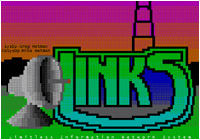 |
 |
• L.I.N.K.S. Co-SysOp, 1994-1997
• The Dark End SysOp, 1992-1994 Introduction to BBS'S 101  Before
the Internet became a household word and the Web meant anything
but a sticky home for spiders, things like chat, downloading and
uploading were already fairly common on what were called BBS's or
Bulletin Board Systems. A BBS allowed you to dialup to a foreign
computer using a modem in the same way you would dialup to an Internet
service provider. The only difference was you were actually connecting
to a personal computer not unlike your own. There you could chat
with the SysOp (short for System Operator) as well as other people
logged on. However, to accommodate more than one person at a time
on a BBS, the SysOp had to invest in multiple phone lines each with
a seperate modem. Each of these phone lines (also called nodes)
would then be connected to the SysOp's computer. Before
the Internet became a household word and the Web meant anything
but a sticky home for spiders, things like chat, downloading and
uploading were already fairly common on what were called BBS's or
Bulletin Board Systems. A BBS allowed you to dialup to a foreign
computer using a modem in the same way you would dialup to an Internet
service provider. The only difference was you were actually connecting
to a personal computer not unlike your own. There you could chat
with the SysOp (short for System Operator) as well as other people
logged on. However, to accommodate more than one person at a time
on a BBS, the SysOp had to invest in multiple phone lines each with
a seperate modem. Each of these phone lines (also called nodes)
would then be connected to the SysOp's computer.Operating a BBS required nothing less than time, dedication and a little investment. A SysOp needed to constantly upgrade to the fastest modems (which for a long time were only 2400 baud compared to today's 56000 baud, DSL and cable modems), purchase lots of hard drive space and generally maintain the quality of their BBS. Fast modems were critical for transferring the latest games, graphics (such as .bmp, .gif and .jpg) and utilities quickly without tying up phone lines. Available hard drive space was important for storing a large number of these files. Quality was absolutely essential as BBS's also featured newsgroups and message boards that sometimes needed to be filtered by offensive messages. In fact some of these message boards were shared among multiple BBS's and were networked to the Internet even before the World Wide Web became popular. BBS's were active throughout the 1980's up until the commercialization of the Internet in 1994 when sending messages, chatting and transfering files could be done much more efficiently -- and you could connect to anywhere in the world. As with the advent of professional web design on the Web, there was also a form of design used on BBS's called ANSI art. ANSI art was very simple as it used the character set now used in full screen MS-DOS mode but took advantage of extended characters and only 16 colors. Extended characters consisted of lines, blocks, shaded blocks and symbols. By combining blocks, shaded blocks and colors, an ANSI artist could accomplish quite a lot. ANSI art was traditionally used in title screens (similiar to a home page on the Web) and menu screens where a user of a BBS could select whether to chat, enter a message board or transfer files. The Dark End, operated by Mike Hetman from March 1992 to August 1994, was one such BBS that was popular primarily for its message boards. The BBS also contained a vast library of files and games and Mike would never hesitate to chat with users, some of which came from as far away as Europe. The period between 1992 and 1994 was also the peak of BBS popularity. In 1994, Mike teamed up with his brother to create L.I.N.K.S. or Limitless Information NetworK System. This much larger system essentially replaced The Dark End and also attracted people from around the world. It contained much more message boards and files and allowed up to four people logged on at once. From 1994 and on, BBS's in general began closing their doors as the Internet became the new medium for many of things only BBS's could once offer. |
|||
|
Copyright © 2003 Mike Hetman |
||||